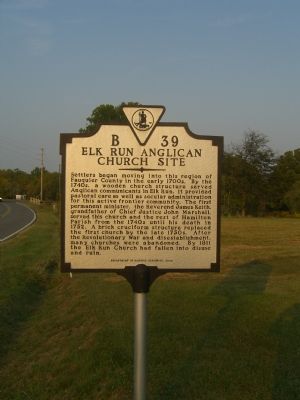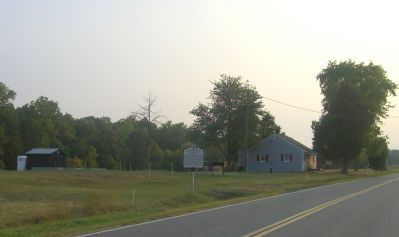Elk Run in Fauquier County, Virginia — The American South (Mid-Atlantic)
Elk Run Anglican Church Site
Erected 2000 by Department of Historic Resources. (Marker Number B-39.)
Topics and series. This historical marker is listed in these topic lists: Churches & Religion • Colonial Era. In addition, it is included in the Virginia Department of Historic Resources (DHR) series list. A significant historical year for this entry is 1752.
Location. 38° 33.254′ N, 77° 40.306′ W. Marker is in Elk Run, Virginia, in Fauquier County. Marker is on Elk Run Road (County Route 806) 0 miles south of Midland Road (County Route 610), on the left when traveling south. Touch for map. Marker is in this post office area: Midland VA 22728, United States of America. Touch for directions.
Other nearby markers. At least 8 other markers are within 7 miles of this marker, measured as the crow flies. Elk Run Village (a few steps from this marker); John Marshall’s Birthplace Park (approx. 4 miles away); Brent Town (approx. 4 miles away); John Marshall’s Birthplace (approx. 4.1 miles away); a different marker also named John Marshall’s Birthplace (approx. 4.4 miles away); German Town (approx. 5.6 miles away); Dalton Reservoir (approx. 6.2 miles away); Stuart and Mosby (approx. 6.6 miles away).
Also see . . . Elk Run Anglican Church Site Preservation Project. More information about the site and efforts to preserve it. A park is planned for this site. (Submitted on September 26, 2007, by Kevin W. of Stafford, Virginia.)
Additional commentary.
1. Current History
Re-discovery of Elk Run and Fauquier County's First Anglican Church began in 1998 when a neighbor started clearing brush on the Elk Run property. Less than a year later, members of St Stephen’s Church in Catlett began to uncover the remains of what was the first brick church in Fauquier County’s mid-1700s frontier.
The Elk Run Church Site Preservation Committee, led by St. Stephen’s, Catlett in collaboration with St. James, Warrenton, is leading the
archaeological effort to preserve this colonial church site. In June of 1999, Ned Browning, the owner of the property and descendant of the first rector Keith, approved of the preservation plan and donated the land to St. Stephen’s .
By exposing 95% of the intact foundation, the all volunteer archaeological team has confirmed that Elk Run Church was a rare Greek cross structure with roughly equal sized extensions on all sides. At least two other pre-Revolutionary Anglican churches in Virginia – Aquia and Abingdon – were built in the cruciform plan.
Until now, the church foundation and artifacts had been hidden from view for about 180 years. Community volunteers under the direction of volunteer archaeologist Dr. John Eddins dug a total of 34 controlled excavation units between April 2000 and June 2002. Findings are plotted on a grid to help track their spatial relationships within the site. To date, found artifacts include handmade nails, ceramic dish fragments, 19th centry coins and Indian arrowheads dating back 5000 years or more.
The team’s speculation about an adjacent cemetery was confirmed in December of 2000 with the discovery of the first grave. Months later, Pete Petrone, whose earlier team discovered an underground ship at the Great Pyramid in 1987, came to Elk Run and conducted remote sensing to determine the church cemetery boundaries,

Photographed By Craig Swain, May 25, 2008
3. Site of the Church
Starting in 2000, excavations on site confirmed the location of both the church and a graveyard. Artifacts recovered include coins from the 19-th and 20-th centuries, hand wrought iron nails, pottery, plaster, along with arrowheads and other prehistoric artifacts.
At the dedication of the historical marker in 2000, colonial church historian Carl Lounsbury of the Williamsburg Foundation said “I am deeply awed by all of you for creating history here. History is ambivalent. These are facts, but facts are useless until you make something of them. We know and we knew for a long time, that there was an Elk Run Church and we had an idea that it might have been cruciform, but it is thank to you and all your volunteers that have actually turned this into a reality. It will then integrate into a public memory of this place. It can only grow as time progresses.”
From a handout available at the site.
— Submitted September 26, 2007, by Kevin W. of Stafford, Virginia.
Credits. This page was last revised on December 25, 2019. It was originally submitted on September 26, 2007, by Kevin W. of Stafford, Virginia. This page has been viewed 2,363 times since then and 52 times this year. Photos: 1, 2. submitted on September 26, 2007, by Kevin W. of Stafford, Virginia. 3. submitted on May 25, 2008, by Craig Swain of Leesburg, Virginia. • J. J. Prats was the editor who published this page.

